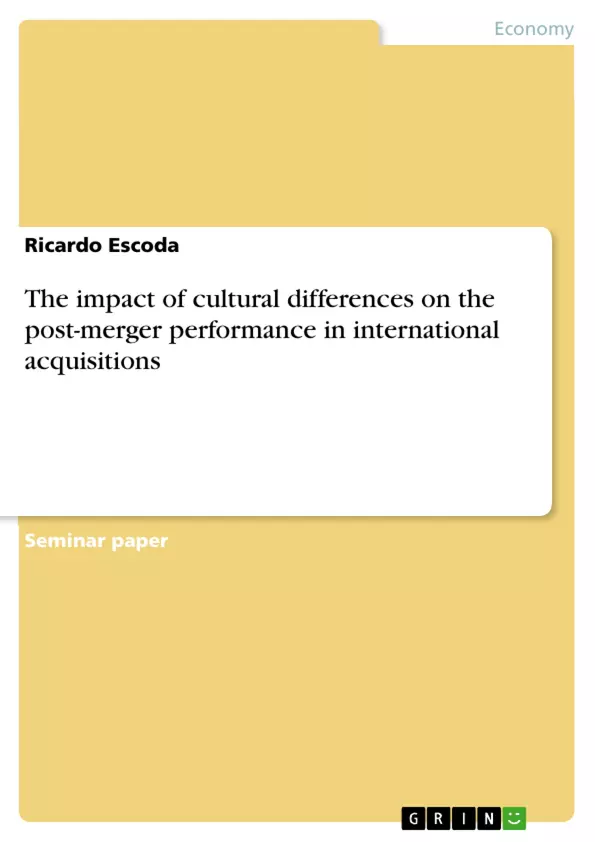As the number of international mergers and acquisitions (M&As) increased formidable during the last decades, it is a highly discussed phenomenon, which is becoming more and more important (Erel et al., 2012). Nearly 30 years ago, in 1987, there have been merely 5.000 M&As worldwide, whereas in 2016 already 50.000 M&As were concluded and latest stats even predict increasing numbers of M&As.
M&A experience might both harm and help post-merger performance in international acquisitions. As stated by Schoenberg (2000) national cultural differences mainly present a strong challenge for cross-border acquisitions. Since the initial financial expectations are met simply by one half of all M&As, cultural differences might be at fault for this high failure rate (Zollo and Meier, 2008). Given that cross-border M&As consolidate two or more different cultures, it has to be taken into consideration that incidents such as differing legislations, currencies, languages and cultural norms do play an essential role. As a result of those distinctions, costs to the integration process might occur and the capability of firms to achieve synergies might be subverted. Thereby, the expected economic advantages of the merger or acquisition will be affected, too. Key factors like the integration of the participating companies in each other and enormous adaptation operations are irrecoverable to accomplish synergies and advantages of M&As.
The hypothesis whether national cultural differences between acquirers and targets are likely to undermine post-merger performance has been researched myriad. An appropriate classification reclines in whether cultural differences matter, when they matter, under what conditions and in which way they do.
The elaboration of this paper is based on the theory of Hofstede (1980), who was one of the first to explicitly address the impact of culture on the integration process of M&As by explaining cultural differences might generate misunderstandings and conflicts between the two merging organisations. Hence the aim of our analysis is to dissect the impact of cultural differences on the post-merger performance in international acquisitions by focussing on two out of four dimensions of Hofstede (1980) by means of the works of Ahern et al. (2009) and Huang et al. (2017).
Inhaltsverzeichnis (Table of Contents)
- 1. Introduction
- 2. Literature Review
- 3. Theoretical Background
- 4. Analysis
- 4.1 Individualism versus Collectivism
- 4.2 Power Distance
- 5. Discussion
- 6. References
- 7. Appendix
Zielsetzung und Themenschwerpunkte (Objectives and Key Themes)
The aim of this paper is to investigate the impact of cultural differences on post-merger performance in international acquisitions. This research focuses on two specific dimensions of cultural differences, Individualism versus Collectivism and Power Distance, as defined by Hofstede (1980). The paper aims to analyze how these cultural differences may affect the integration process of merging organizations and ultimately, impact their post-merger performance.
- The role of cultural differences in international mergers and acquisitions (M&As)
- The impact of cultural differences on post-merger performance
- The influence of Hofstede's cultural dimensions on the integration process
- The implications of cultural differences for knowledge transfer and economic performance
- The challenges and opportunities presented by cross-border M&As
Zusammenfassung der Kapitel (Chapter Summaries)
The paper begins with an introduction that sets the stage for the research by highlighting the increasing importance of international M&As and the potential challenges posed by cultural differences. This is followed by a literature review that provides a comprehensive overview of existing research on the topic, identifying relevant studies and theoretical frameworks. Chapter 3 delves into the theoretical background, presenting Hofstede's (1980) model of cultural dimensions as the foundation for the subsequent analysis.
The analysis section, divided into two parts, examines the impact of Individualism versus Collectivism and Power Distance on post-merger performance. The paper concludes with a discussion section that explores the implications of the findings and outlines limitations for further research.
Schlüsselwörter (Keywords)
The central keywords of this paper encompass international mergers and acquisitions (M&As), cultural differences, post-merger performance, Hofstede's cultural dimensions (Individualism versus Collectivism, Power Distance), integration process, knowledge transfer, and cross-border M&As. The study emphasizes the relationship between cultural differences, particularly as defined by Hofstede's framework, and the challenges and opportunities of post-merger integration in international acquisitions.
- Quote paper
- Ricardo Escoda (Author), 2017, The impact of cultural differences on the post-merger performance in international acquisitions, Munich, GRIN Verlag, https://www.grin.com/document/373480



